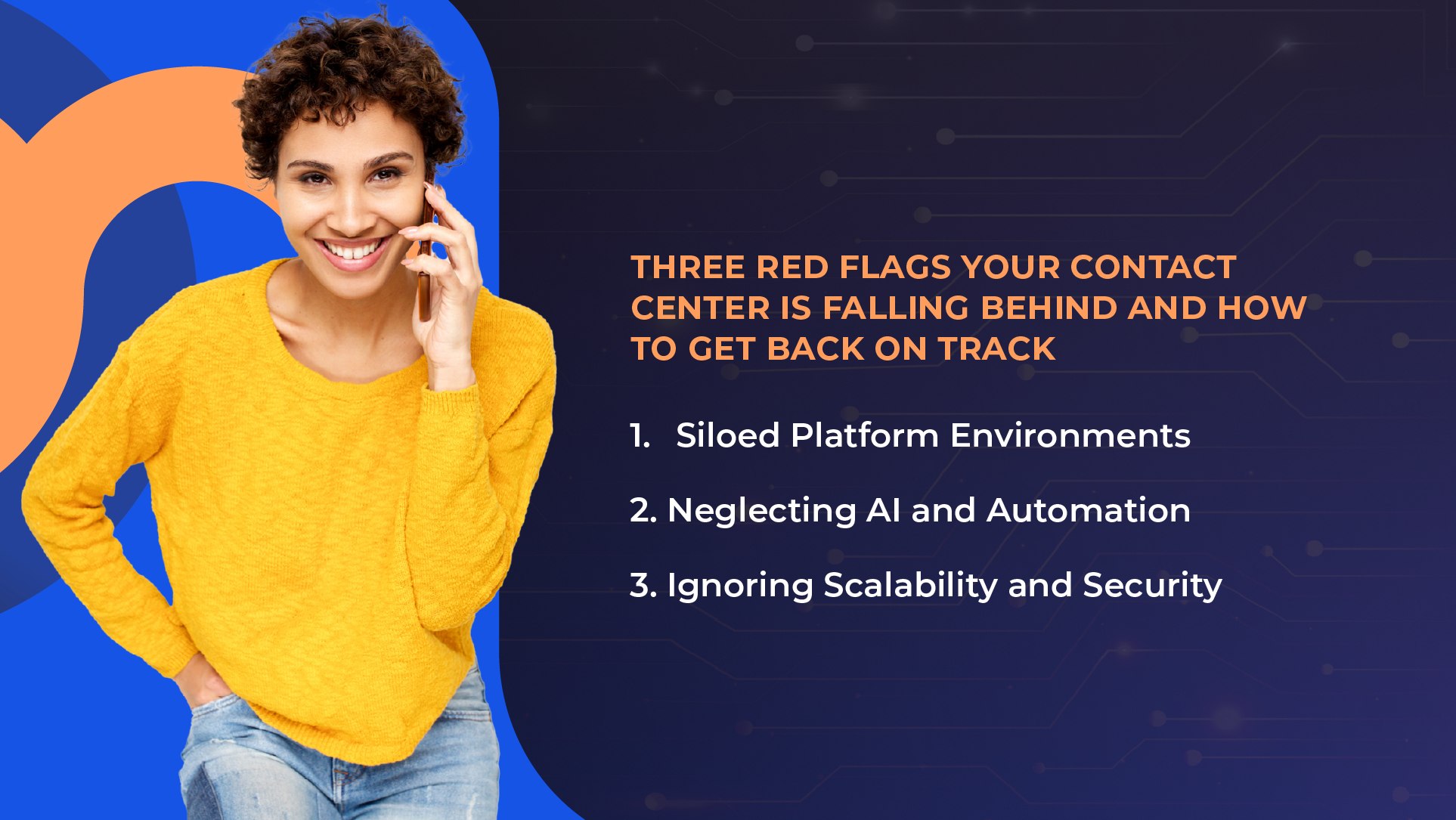In today’s digital world, your competitors are no more than a click away, drastically increasing the importance of delivering personalized customer experiences (CX) on the first go. Case in point, PWC highlights that a staggering 32% of customers would walk away after just one bad interaction, underscoring the significance of meeting your customers' needs on the first try — every time. Creating a seamless and customer-centric contact center that ensures you’re staying ahead of the competition requires a comprehensive digital transformation strategy. The question is — where do you begin?
Success starts with an honest assessment of your organization's weaknesses. In this blog, we’ll explore three common red flags indicating your contact center is falling behind, and, more importantly, we share strategies to help you get back on track.
|
Red Flag #1 |
Siloed Platform Environments |
|
Red Flag #2 |
Neglecting AI and Automation |
|
Red Flag #3 |
Ignoring Scalability and Security |

Red Flag #1: Siloed Platform Environments
Consider a scenario where your contact center solution operates independently of your other platforms. Consequently, your self-service channels don’t have access to the information needed to answer incoming inquiries, forcing customers to connect with a live agent to whom they need to restate their identity and reason for calling. The agent, in turn, is taking notes in one system, managing the conversation in a second, and resolving the issue in a third. To make matters worse, the broken process and disconnected data make it even more complicated for the agent to find the information they need to rapidly address the customer's inquiry. As a result, a vast amount of time is wasted on mundane, manual, and time-consuming tasks. Sounds like your organization? You’re far from alone! According to Kate Leggett, VP and Principal Analyst at Forrester, 68% of CRM decision-makers are experiencing difficulties assessing a single view of the customer, and 48% report struggling with driving effective customer insights.
Inefficient workflows and processes arise with fragmented operations, where communication channels and data management platforms don’t speak with each other. If your contact center isn’t embedded within your CRM or service management platform — such as ServiceNow or SAP — it’s time to raise an eyebrow. As Kathy Ross, Sr Director Analyst at Gartner, explains, "When a service organization builds paths to resolution through digital channels that are independent of assisted-service channels, it may result in a disconnected, high-effort customer service experience.” Native integration of cloud contact center capabilities with your CRM or service management platform streamlines operations by providing agents with all the information they need through a single offering and solution, reducing issue resolution times and improving personalized customer experiences.
Red Flag #2: Neglecting the Power of AI and Automation
AI and automation capabilities are more than just temporary trends — they are a pivotal part of optimizing operational efficiency. If you’re not already using AI, you might still question why you should. Artificial intelligence in customer service enhances your communication platforms with intelligent self-service, automated workflows & call transcripts, customer sentiment insights, AI Coaching — and much more — to elevate the overall experience without increasing manual efforts. Gartner predicts that “80% of customer service and support organizations will be applying generative AI technology in some form to improve agent productivity and customer experience (CX)”. Their research also states that 38% of leaders deploy these applications with the explicit goal of improving customer experience and retention. Failure to harness the potential of AI and automation capabilities is a clear warning sign, indicating that your contact center operations are falling behind.
Consider self-service — a critical part of the contact center, gaining increased significance among the next generation of customers. Gartner research reveals that 52% of Gen Z and millennials would never purchase from an organization again if their issue couldn’t be solved through self-service means. So, how do you make sure your virtual agents are equipped to answer at least a majority of inquiries? It all comes down to implementing always-on, intelligent self-service. AI-powered virtual assistants can efficiently and automatically handle simple and repetitive requests, improving your call-to-resolution time without the need for additional headcount. When a customer wants to speak with a human, AI capabilities equip that agent with the valuable insights and real-time recommendations they need to solve the issue immediately.
Yet, AI is so much more than a frontline customer service tool! When integrated deeply with your CRM or service management platform, it delivers automatic call transcriptions and GenAI-powered summaries, sentiment analysis for 100% of customer interactions, customized performance plans and AI Coaching for your agents, and much more. As explained by Gartner: “The generative AI use cases with the highest ROI are ones that provide reps with context around the customer, product and interaction, as well as guidance on how to best solve the customer's issue. In fact, our recent research shows that reps whose technology provides them with context and guidance tend to perform better than those without these capabilities.” The real value of AI and automation comes from providing your contact center with the insights and reports needed to develop high-performing agents, ultimately delivering outstanding customer service.
Red Flag #3: Ignoring Scalability and Security Concerns
The final red flag revolves around business growth. If your organization is struggling to scale your contact center to effectively handle growing volumes of customer inquiries, you’re at risk of being surpassed by more innovative competitors. On the other hand — when scaling your organization to meet customer needs, you could potentially run the risk of losing control of your data. Why is that? There’s a correlation between AI, scalability, and security. While capabilities such as Generative AI and Conversational AI can boost your business growth, there’s a public fear associated with their potential security risks.
So, what’s the connection between scalability and AI? Scalability becomes effortless when processes are automated, leaving simple contact center tasks to the AI and complex issues to your agents — allowing your organization to handle more requests without hiring additional agents. As explained by Aragon Research: “Intelligent automation systems can scale operations up or down quickly, adapting to changing business demands. They offer the flexibility to handle increased workloads without compromising quality or efficiency”. But, what about the security concerns? While AI helps drastically improve customer interactions, it needs insight into the system of record to understand and answer specific issues for each customer. Hence, one leading concern among organizations is how the data is being used and stored. If your data is collected and stored by the AI, instead of in your own system of record, your organization loses control.
You're in luck — there's an easy way to prevent this security concern! One way to scale your organization while also keeping your data securely stored is to natively embed AI-powered cloud contact center capabilities into the CRM or service management platform you already use (such as ServiceNow or SAP). Instead of exporting customer data to a new platform, an integrated AI solution accesses data directly through your system of record to match an incoming inquiry with a contact record. In other words, you can keep the data where it already resides, and only share with the AI what’s needed to answer and accurately log incoming inquiries. Your organization can — with confidence — ensure compliance with regulatory industry standards yet seamlessly deliver personalized experiences to customers and employees.
This is precisely the approach taken by 3CLogic, seamlessly embedding cloud contact center capabilities within the CRM or service management platform to improve the experience and increase ROI — without taking advantage of customer data.
Conclusion
In the dynamic and ever-changing world of customer service, a strategic approach towards data management and advanced platform capabilities is a must. Addressing the red flags discussed in this blog will help you set the stage for an efficient and secure contact center. To avoid falling behind, embrace the power of integration, innovation, and scalability. If you’d like to learn more, we suggest reading our blog “Top 5 CX Strategies to Optimize Your Contact Center in 2024,” where we provide core strategies to beat the competition — today and tomorrow. For a more personalized approach, schedule a meeting with one of our certified experts. They’ll help guide you through how your specific organization can reach long-term customer engagement success.





